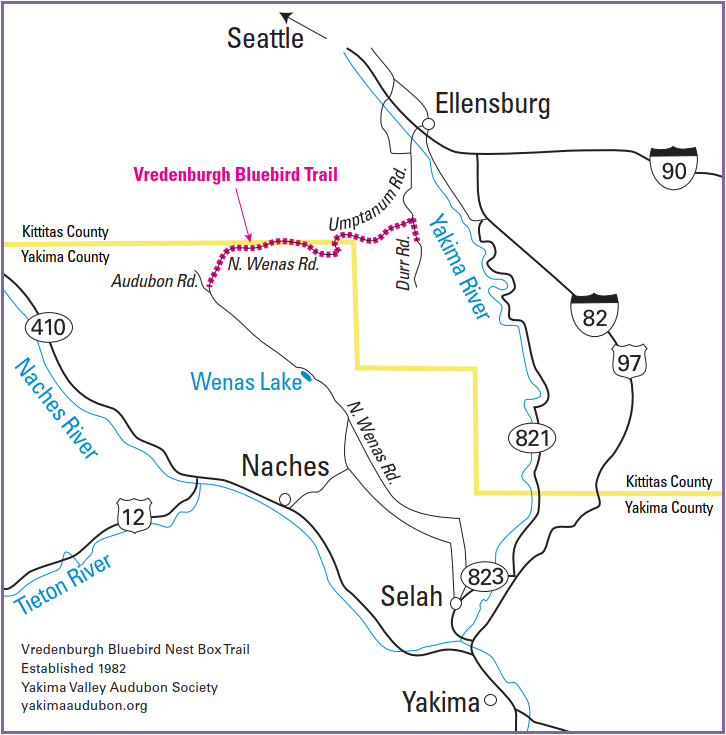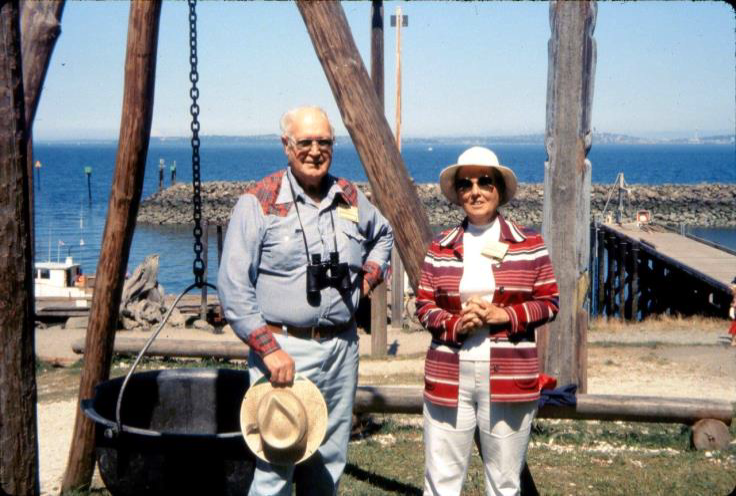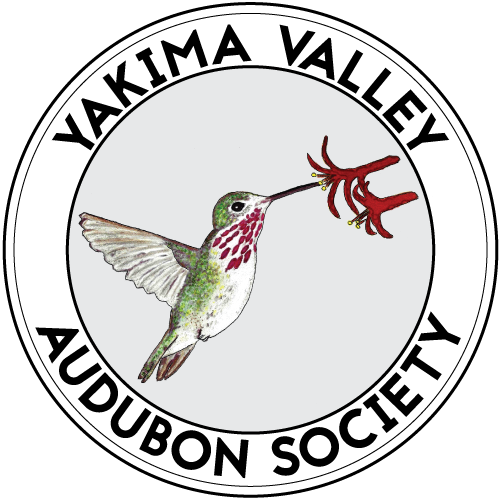Bluebirds
- Vredenburgh Trail Results
- Viewing Bluebirds
- Bluebirds - who, what, where, when, why?
- History of the Vredenburgh Bluebird Trail
Vredenburgh Trail Results
- 2021 Vredenburgh Bluebird Trail Report
- 2020 Vredenburgh Bluebird Trail Report
- Fledge Results Vredenburgh Bluebird Trail 1982-2021
Viewing Bluebirds

Bluebirds - who, what, where, when, why?
The Vredenburgh Bluebird Trail is comprised of 152 nest boxes along a sixteen mile stretch of roads. The lower end of the trail begins at the end of the pavement on North Wenas Road in Yakima County and ends at the beginning of the pavement on Umptanum Road in Kittitas County; the road name changes as it crosses the county line. The entire trail is on dirt roads that can be challenging with ice and snow in the winter or mud and flooding in early spring.
Bluebirds arrive from their wintering grounds as early as February but become much more visible when tending to nestlings in boxes from mid-May thru June. They hunt insects from low perches and can be seen on fences, shrubs, and power lines. The boxes provide nesting sites that are otherwise limited in suitable bluebird habitat.
History of the Vredenburgh Bluebird Trail
Volunteers Reap Success of Wenas Bluebird Trail
By Jeanne Crawford - Special to the Herald-Republic
An estimated 386 young bluebirds are now wintering in areas south of here - in both eastern and western Oregon, eastern Nevada, eastern California, even perhaps in northern Mexico -fledged from the 125 nesting boxes made available to their parents by the Yakima Valley Audubon Society.
Since 1982, the society has maintained a 15-mile long bluebird trail along Wenas Road beginning where the road’s pavement ends and continuing to its junction with Durr Road.
Virginia Vredenburgh and her late husband, Harold, put out the first boxes in 1981. “The first time I looked into a bluebird box and saw those darling little birds, it was love at first sight,” she recalled.

Following the lead of the late Bill Thoren, a birder who had found the Wenas area similar to the Montana he had left and who put out the first bluebird boxes, the Vredenburghs and other Auduboners spent a cold, wintry day in an Oak Creek Game Range barn building boxes. In spring 1982, they put out 58 homes for the songbirds.
In 1994, the Wenas trail was re-named the Vredenburgh Bluebird Trail in honor of the couple.
According to Vredenburgh, who is the continuing trail chairman, there are two species of bluebirds in this area, the mountain and western. Male mountain bluebirds are all blue and male westerns are blue with rusty breasts. Females of both species are dressed in more subdued colors.
The western bluebirds prefer trees. The first half of the Wenas Bluebird Trail is at lower elevation, around 2,000 feet, where trees are plentiful.
The mountain bluebirds choose a more open habitat, offered at the easterly end of the trail at about 2,500 feet.
Bluebirds begin their return to the Wenas the last week in February, according to Vredenburgh. The last Saturday of March is traditionally set aside for Audubon members to go en masse to the Wenas area to repair boxes and install new ones where necessary.
From the end of April to mid-August, weekly monitoring is shared by members who check each box, trying not to frighten sitting birds while counting eggs and, later, the hatched babies.
Bob Boekelheide, wildlife biologist, banded bluebirds, including the tiniest chicks, over a period of several years and found that they do indeed return to nesting boxes within a few hundred yards of where they had previously nested or had hatched.
The bluebird trail is a major project of the Audubon Society. The houses are ‘rented’ to subscribers, two years for $5. More than 100 of them are currently leased out, many to Western Washington Auduboners.
In addition to the Audubon Society’s Vredenburgh trail, there are six additional ones, privately maintained and monitored by bird lovers who “just want their own project,” Vredenburgh said.
The six trails include more than 200 boxes, about half of them in the Wenas, the others along Chinook Pass highway and the South Fork of the Ahtanum.
Vredenburgh also tallies the totals from these trails. In 1995, 597 bluebirds were fledged from these nests, making a grand total of 983 fledged bluebirds.
Complete records of the past 14 years are in Vredenburgh’s files: box number, its renter, how many eggs laid, how many baby birds hatched, how many fledged, how many times the nest was used.
Her complete 1995 report appears in the October issue of the Society’s monthly newsletter, The Calliope Crier.
According to Birder Andy Stepniewski, the bluebird trail project has increased available habitat for the nesting birds.
The birds would have no other place to go, he said, as all available habitat is occupied. He said that both species have declined greatly over most of their ranges because of loss of natural cavities for nesting, logging operations and removal of snags. Many remaining nesting cavities have been taken over by the aggressive starling, he said.
-
The preceeding article was written by the late Jeanne Crawford, pictured below and was printed in the Yakima Herald-Republic - exact date unknown but likely in late 1995 given the number of 386 young bluebirds mentioned in the first sentence.

